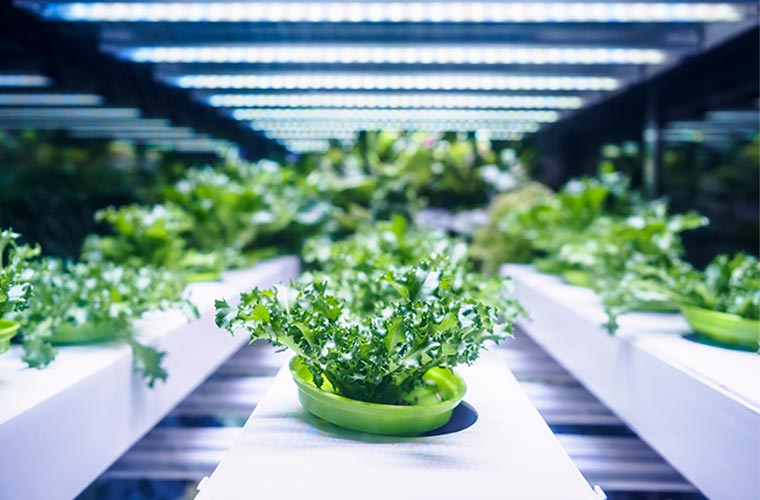Using solid-state lighting for indoor growing operations offers a lot of benefits. While something like medical lighting benefits and uses may be fairly straightforward, LEDs in agriculture can seem like more of an art than a science. Still, whether it’s cannabis, mini greens, or other cash crops, distributors are missing out if they’re not keeping up with the latest developments.
Some Major Differences in Agriculture
Say goodbye to lumens. Horticulturalists speak in terms of micromoles and foot-candles – the number of photons that reach the surface of a given area. The dispersion of the light from five feet above a 10-foot table doesn’t work if measured in brightness, says Greg Lonergan, agronomic consultant at WS Solutions.
The range of light that plants benefit from is also on a much narrower set of bandwidths. “An overwhelming majority of the chlorophyll cells are classified -A and -B, which respond to relatively narrow bands of blue and red light,” Lonergan adds. Daylight LEDs are, in fact, rarely helpful in a greenhouse unless they’re used for observation of plant conditions in case there needs to be a change in care.
Where Distributors Come In
Several agricultural experts from across the country note that projects that already have conditions amenable to distributors like hotels and offices would also benefit from agricultural lighting. Some hotels already highlight their on-site growing, either in a lobby or at the front of the restaurant.
With LEED green certifications, the focus on locally-produced food becomes as much a marketing benefit as saving the cost of purchasing ingredients from a wholesaler. In fact, even small farm-to-table restaurants have tried out the technology.
The financial benefits are immediately apparent to farmers. “I sell growth,” Lonergan says, noting that one client was able to cut production time from about 50 days to 23 days.
The major issue is the initial investment, but energy companies are offering rebates. Agriculture requires massive amounts of energy, so being able to predict demand when the power grid is a mishmash of generators is crucial.
Where the Green Grass Grows
In states where marijuana cultivation is legal, the technology behind it is most akin to what distributors already see. That includes sophisticated sensors for moisture and temperature, a focus on cooling, and particular lighting requirements. One way to achieve those results is with small pods that may be just eight feet by eight feet.
With some of the latest pods, “You’re actually seeing lights on tracks that move according to what the plants need at that particular time,” according to Ian Cumming of WiSilica. The controls that can help automate this are what make it interesting and a point of entry for distributors.
So, too, is the focus on energy savings. Recent product offerings have cut the utility bills by up to 75 percent, leveraging heat dissipation through specialized tiles and coatings in the pods and facilities, notes Cumming. At this stage, some of the largest growers in Colorado and Arizona have what are effectively massive clean rooms to ensure quality.
The marijuana market is estimated to be a $20 billion industry by 2021 and could grow as states legalize it for medical and recreational use. The profit margins for growers are significant enough that it could rival spice production.
What Else to Watch: Personal and Small-Scale Growing Options
As with other LED applications, it’s possible that the consumer market can help drive the interest in commercial real estate for these offerings. Just as smart homes helped pique interest in the Internet of Things and connected devices, so, too, might home gardens.
“We’re past early adopter stage when it comes to agricultural lighting,” Lonergan says. “Where the biggest growth will come in the next year or two is in household gardens.” Inside homes, this would allow people to grow salads and herbs during the winter regardless of where they live.
Advancements continue to be made, but Lonergan makes the comparison to personal computers. If you didn’t buy a computer in the 1980s or 1990s, just to wait for a more advanced alternative, Lonergan says, “You’d be ashamed of yourself.”
Tagged with agriculture, lightED
Very interesting.
Now where can an average distributor guy learn more about this stuff?
Even having my eye on this market for a while, there are some new things mentioned in this article.
It would be nice to get some sources.
Or stated in a different way: what should an interested distributor read next?